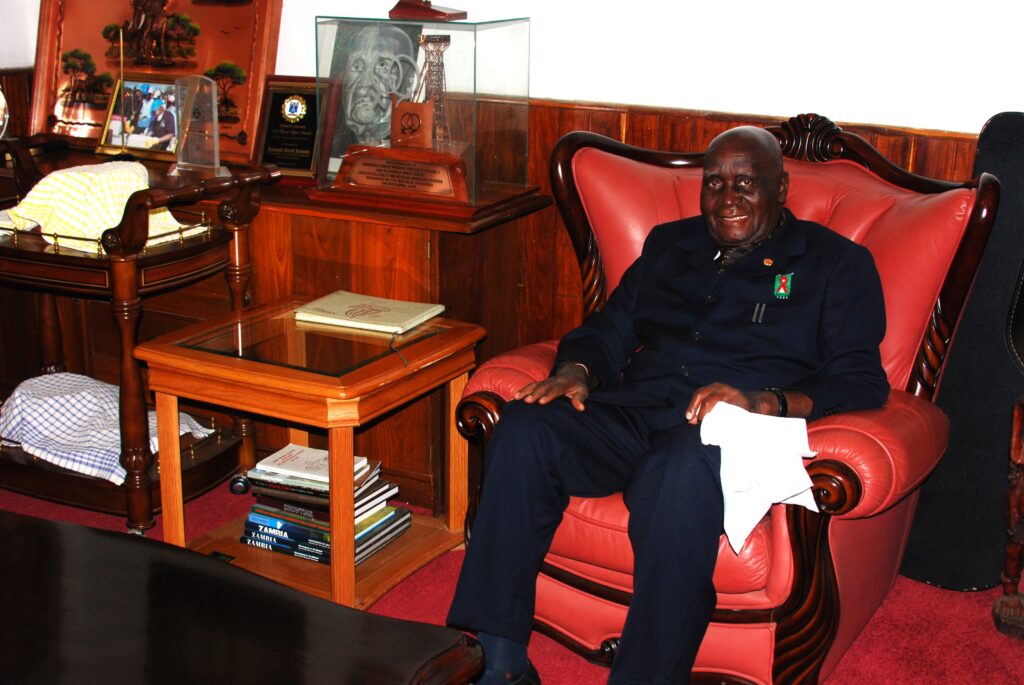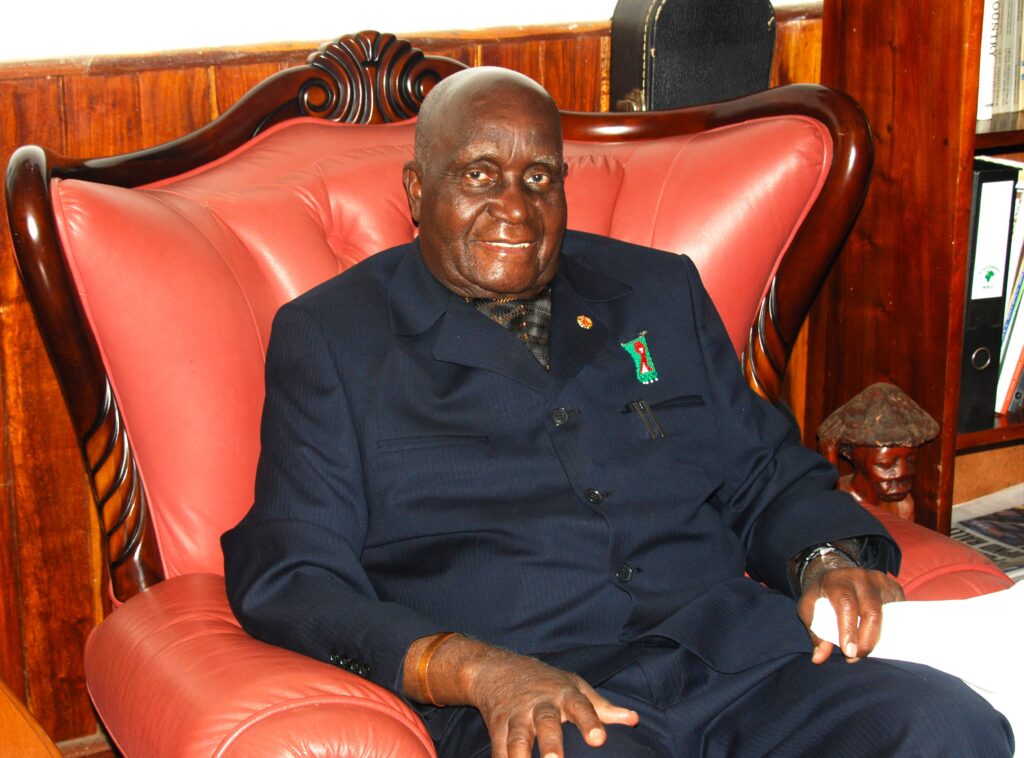by
Mwizenge S. Tembo, Ph. D.
Emeritus Professor of Sociology
(Names of people have been changed to respect their privacy)
“Your—- excellency, Sir, ehh!!!” I said still stuttering but regaining my composure. “My boss, President Hansen of Oakhill University College has sent me to ask if you could come and address our students at the college. The fifteen hundred students at the Christian school are mostly white. They would be honored and would learn a lot about Africa and Zambia if you visited us.”
“Mr. Mufwaya!” President Kaunda calmly called as I was talking. “Have you found it?”
“Not yet, Mukwayi,” Mr. Mufwaya replied from the kitchen. “I am starting to do laundry.”
Conversations went back and forth with his staff as the President and I talked. He said he and Mr. Mufwaya would look at his schedule. We can discuss the date and details later. As I was realizing my five minutes would be up soon, a spontaneous urge came over me about the numerous questions I had been curious to ask him for many years.

“Sir, I have been curious for many years. What was it like to meet South African Prime Minister Vorster in the train car in the middle of the Zambezi railway Victoria Falls bridge in the fight against white racist apartheid policy in South Africa?”
President Kaunda’s face animated and eyes suddenly sparkled with passion. He began to describe to me that he had been doing everything or anything to fight and negotiate to dismantle apartheid. He knew that without the peaceful resolution of apartheid, there would be terrible bloodshed in the whole of Southern Africa. His sudden passion was as if my question had turned on a switch.
“Vorster was very treacherous… deceitful…insincere….” Suddenly President Kaunda paused in thought. It was as if he had realized something. “If you were……well young man….” His voice faded away.
“Mr. Mufwaya! Are you ready?” President Kaunda suddenly yelled.
“No!” Mr. Mufwaya replied from the kitchen. “Mukwayi, I am busy doing laundry and doing some house work today. Can he take my place?”
I was not paying attention to the conversations because I knew my five minutes were nearly up and I was very happy and ready to leave.
“Young man, can you play golf?” President Kuanda suddenly asked.
I glanced around me because I thought the question was directed at someone else behind me. There was no one else behind me.
“You mean me?” I jabbed at my chest with my forefinger.
“Yes!”
“Yes, of course!” my sudden emphatic reply shocked me. What was I doing?
“Mr. Mufwaya, can you get and lend your golf shirt to the Professor?”
Since I was a young boy from the village through secondary school, I was the worst person at sports. In the chifwayo soccer or football I played with other boys using a ball tied with rags and tree fiber, the choice of who would be on the two teams was always humiliating for me. I was last to be chosen. If the total number of players was an odd number like 7 or 9, I was last and the one player who both teams willingly said: “You can have Mwizenge on your team! He doesn’t matter.” The teams would then play with my team having 4 players against 3 or 5 against 4. One time when I was at the Prestigious Chizongwe Secondary School, I tried to learn how to play tennis singles with my classmates Charlie, Mike, Ben and Ruskin in 1970. I failed miserably.
For some reason, when I was doing my Ph. D. at Michigan State University in 1985, I decided to learn how to play golf. I took ten lessons. I thanked my stars because today twenty-one years later in 2006, I was going to be able to play golf with my hero President Kaunda. What a lucky son of a gun? God sometimes blesses fools like myself. I thought to myself.
When we arrived at the golf course for tee off, a 65-year-old African-American man was paired with his 30-year-old son. President Kaunda and I were paired. The President was going to drive our golf cart. At that moment, a million thoughts rushed through my head. There were no cell phones yet for me to take selfies. I wished at that moment that my parents, my brothers and sisters, family members in Zambia and America, my wife, and my childhood friends were there to see me play golf with President Kaunda. Who was going to believe this? Even I could not believe it. It felt like a dream.
After a few minutes of these fantasies, I made one important decision: to enjoy every second and minute of my 18 rare holes of golf with President Kaunda. I decided to talk little but see, hear, smile, smell, and laugh. You can never really enjoy special moments if you are trying to talk at the same time during the whole time.
I was not going to try to be a golf hero hitting the ball 300 yards or 275 meters. If you hit the ball too wildly as a terrible golfer myself, the ball would end up in the bushes under trees. You waste time looking for the ball in thick bushes. I decided I was going to play it very safe. I would drive the ball for about 100 yards or 91 meters in the middle of the fare way. And that’s what I did for 18 holes. I avoided embarrassing myself. President Kaunda had one of the smoothest beautiful swings in golf I had ever seen.
As we were motoring toward the 18th hole, it was getting dark, cold, and raining. I held our large umbrella as President Kaunda drove our cart. When we arrived back at the apartment, I was thoroughly content to leave. I told my hosts I was going to leave to find a motel room, sleep, and fly out of Boston in the morning at 8:00hrs. President Kaunda would not hear it. He said I was welcome to sleep in the one spare bedroom they had.
We did not call a taxi or get a limousine to go out to a restaurant for dinner. President Kaunda took a warm bath. All five of us walked, with President Kaunda in the middle, in a single file along the sidewalk of the busy city street at night in the City of Boston, the way we walk on a bush path between rural villages in Zambia.
After four blocks, we arrived at an Indian Restaurant where we ate a delicious dinner amidst jokes and hearty laughter. When we arrived back at the apartment late that evening, I bid President Kaunda goodbye thanking him for the great wonderful time I had. When I hugged him good night, I noticed he was so tall that my forehead barely touched the bottom of his chest. Early the following morning, Mr. Phiri escorted me to the railway station on my way back to Boston Logan International airport for my flight back Washington, D. C. to Oakhill University College.



